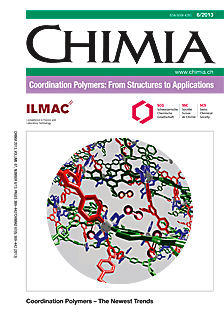R-isophthalic Acid-based Coordination Polymers (R = Hydrogen or Bromine)
DOI:
https://doi.org/10.2533/chimia.2013.393Keywords:
1d and 2d polymers, Coordination polymers, Isophthalic acid, N ligands, Solvothermal reactionAbstract
Three new R-isophthalic acid-based (R = H or Br) coordination polymers have been designed and synthesized. By changing the N-containing ligand in the system, we are able to tune the dimensionality of coordination polymers from one-dimension (1D) to two-dimensions (2D) with the same basic building unit. Also, different metal ions can be incorporated into the same structures. Compound 1 [Cu(bipa)(py)2]·0.5(H2O) (H2bipa = 5-bromoisophthalic acid; py = pyridine) and compound 2 [Co(bipa)(py)2] are 1D chain structures. Compound 3 [Cu8(ipa)8(bpe)8]·2(bpe)·4(H2O) (bpe=1,2-bis(4-pyridyl)ethane) is a 2D layered structure.Downloads
Published
2013-06-26
Issue
Section
Scientific Articles
License
Copyright (c) 2013 Swiss Chemical Society

This work is licensed under a Creative Commons Attribution-NonCommercial 4.0 International License.
How to Cite
[1]
R. Zhang, Q. Gong, T. J. Emge, D. Banerjee, J. Li, Chimia 2013, 67, 393, DOI: 10.2533/chimia.2013.393.







